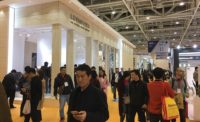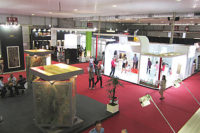According to show organizers, there were approximately 2,000 exhibitors filling over 1.7 million square feet of exhibit hall space, representing 54 different countries, including national pavilions from Turkey, Brazil, Italy, Egypt, Spain, Portugal, France, Finland, Greece, Pakistan, Mexico, Iran and India. Not surprisingly, the largest groups of international exhibitors came from Italy (over 15%), Brazil (8.5%) and India (6.75%).
Claims of 142,498 attendees would normally sound highly exaggerated, but the halls here were filled, so I can believe these numbers. A total of 27,000 of the attendees were from overseas, hailing from 148 different countries, and all of these statistics represent record highs for the fair. The level of business being done in China, both buying and selling, makes it an important destination for the stone industry, and in Xiamen, the country offers a port city with a growing infrastructure, including many new or updated hotels, and a new airport.
Xiamen is on the southeast coast of China, in Fujian province, and nearby, to the northeast, sits the town of Shuitou, which is home to a booming stone processing industry. Shuitou utilizes Xiamen as its port and appropriately boasts an ancient 5-mile-long bridge made of slabs of stone (along with a more modern, shorter bridge for convenience). Growth in Xiamen has been fairly unbelievable, with the population alone growing from 2 million to 3.5 million between 2000 and 2010, and they have invested approximately $5 billion in their infrastructure in the last few years alone.
Some of the exhibitors at the show were presenting finished products, just as you see at most shows. Large manufacturers from Europe, South America, India, the U.S. and throughout Asia were exhibiting, and the owners or directors were in the stands. Alberto Antolini of Antolini Luigi summed it up when he said, “We are here because we need to be here. It is too important a market for us not to be here. My company has been here before, but now I realize I need to be here.” And the major buyers were there in full force as well. Jonathan Zanger, president of Walker Zanger, said, “The Xiamen Fair is a great venue to see how the industry is growing in China, and how the world is serving that market, which is so different from our own.”
Block sales were a large part of the activity at the exhibition also, and not just from Brazil, India and many of the other usual sources. RED Graniti exhibit actually showcased two white marbles (Calacatta Golden and Calacatta Lincoln) from its quarries in Colorado — one of its newest ventures. Additionally, quarriers from the U.S. were there to see their clients and make sure they are seeing the trends that are being established in the field.
While I expected to see many American buyers at the show, I was surprised to see how many companies from the U.S. were there selling stone to the Chinese. Bob Campo, Vice President of Sales and Marketing for Rock of Ages, a large quarrier of granite in the U.S., said they need to be at the epicenter of their largest client base. “As China represents our largest export market for our granite blocks, it is important for us to attend this exhibition to meet and interact with our customers as well as to network with others within the stone industry,” he explained. “It also gives an opportunity for our production people to review and purchase the latest equipment and innovations related to quarrying and manufacturing. The Xiamen Stone Fair has grown to be one of the largest and most important exhibitions for anything related to stone.” Another U.S. quarrier, Coldspring, one of the largest stone suppliers in the world, was also there to see customers. Senior Vice President, Dan Rea, summed up their attendance by stating, “Coldspring has exhibited at the Xiamen Stone Fair since 2009. The stone industry was growing in China, and we were experiencing increased interest in our materials from the larger manufacturers.
The firms were seeking blocks of granite and limestone from Coldspring’s quarries to fulfill the numerous architectural specifications for projects in Asia and around the world. Attending and exhibiting at this show has enabled us the opportunity to create long-lasting relationships with other leaders in the natural stone manufacturing industry.”
It was interesting to see that many exhibitors were there solely to sell blocks, especially many I saw from Greece and Turkey. Ali Sayakci, General Manager of Sayakci Natural Stone, a Turkish marble quarrier, said, “We stopped processing tiles and slabs — there was no money to be made. Now I sell my blocks directly to China. There is a market for this, and we are doing well this way.”
Another notable quarrier exhibiting in Xiamen was the newly merged company formed by the joining of Finnish quarrier, Palin Granit, and its Norwegian counterpart, Lundhs, which is now Northern Europe’s largest quarrier.
Large Chinese suppliers, such as Best Cheer Stone, Kang Li Stone, Jianmang Stone Group and Hongyi Stone were among many who had elaborate stands in the main halls. Best Cheer Stone also held a 20th anniversary party at the Kempinski Hotel, with a reception that seemed to include most of the larger international companies at the fair. Quartz manufacturers were also in full force in China, with manufacturer Color Quartz leading the way and holding its own reception at a Texas barbecue in Xiamen, China!
On the technology side of things, there were endless displays of tooling — it would be difficult to distinguish one company from the next. Many of the largest machinery manufacturers were there as well, luckily grouped together in one area, for the most part. One surprise was seeing a templating system, displayed by Laser Products, being demonstrated to Chinese installers. Dan Louis, CEO of Laser Products, said that China is by far the biggest potential market for their products. “The leads I get at a show like this are spectacular,” he said. As far as seeing new trends in manufacturing and tooling, John Blick, president of Blick Industries, said, “We’re here to see what’s happening in the world and to see what’s next, but we’re not seeing anything that makes us worry that we’re behind the curve.”
Pavilions were set up to promote suppliers from Italy (both stone and machinery sectors were represented), Brazil, Spain, India and other countries. But the Brazilians took it to another level with a special barbecue tent set up for lunch every day, where Brazilian exhibitors could bring their clients and employees to a Brazilian churrascaria lunch where Cafu, the legendary Brazilian soccer star captain who played on two Brazilian World Cup champion teams, was signing soccer balls and posing for photographs. This tent and promotional program was produced by Abirochas (Brazilian Association of the Dimension Stone Industry) and Apex (Brazilian Trade and Investment Promotion Agency).
Show organizers included educational seminars at this year’s event, aimed at the international community, including a “Stone Summit” that featured international speakers, and they have promised more events like these for the future.
The show, organized by Xiamen Jinhongxin Exhibition Co., will be held on the same dates in 2015: March 6 through 9. I imagine we will be reporting on this show for years to come.




